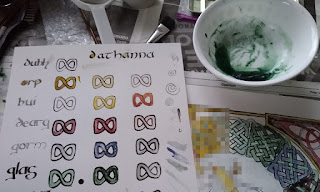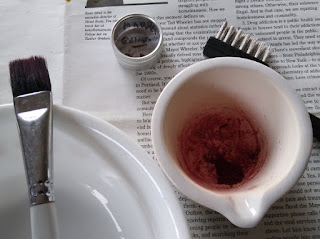At long last, it's done.
But I cannot publish the finished art because of the rules of the contest. I can publish the low resolution color test sheet, with all its mistakes and scribbles:
What I learned: those monks are metal. Even limiting myself to natural materials and the morning light, I still had the advantage of central heating and food security. And modern conveniences. If poor Brother Cadfael wanted a hot cup of coffee, he had to wait for the Renaissance. Tea wasn't much better. Whatever hot drink...herbal tea, beer, wine...it would have been a hassle to heat it up. There was no microwave in the scriptorum!
While I succeeded in creating colors from all natural sources ( to which some pedant will say: "Actually, petroleum is a natural source". Dun do bheal!), I completely failed at even coming close to a majority of the original pigments. Historical pigments used:
Gall Ink
Indigo
And that's it.
Now if I was to expand that to pigments documented to be used in the Middle Ages, we can add:
Iris Green
Zinc
Any lake puts us in the Renaissance. Sticking to known medieval practices, the best I could say is 4. But all natural sourced... that is, what a monk or medieval artist could make with the materials and technology of the time.
Here's the color sheet with source pigments labeled:
As for the contest, feicfimid.
.


















